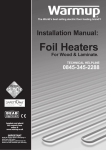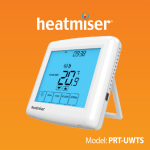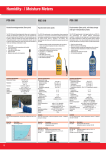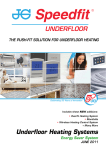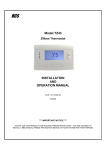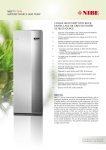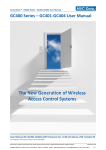Download Nibe user manual 370
Transcript
Home owner user pack for the Nibe F370 How to use this pack: Section 1 – Please print these pages and laminate back to back to create a single document. This laminated document should be left with the Unit at all times. Section 2 – Please print these pages and bind together. This bound document should be included in the home owner pack provided to all tenants. Section 1 NIBE Quick Start User Guide Welcome to your home and your NIBE heating system. This is a Swedish heating system designed to run fully on electric power to provide you with heating and hot water. How does it work? You may notice white circular ducts in your kitchen and bathroom. The NIBE unit draws the warm air from these ducts into the unit and takes the heat from the air to help provide you with heating and hot water. The air taken out by the NIBE system is replaced by air coming into your house through ducts in the wall and is circulated through the home via the air gap under the internal doors. This system is designed to work 24 hours a day which is the most efficient and cost effective way to heat a home. Quick Start Guide 1. Set the temperature: When you move into your home you will need to set the temperature to suit you. The mode for setting the indoor temperature is reached, when in the start mode in the main menu, by pressing the OK button twice 2. Set the season: The NIBE can be run on three settings however to minimise your heating bill we suggest the following. Enter the Heatpump menu (4) and select the operating mode. Select manual and adjust using the chart below. NB Deactivated = Crossed out Use Summer mode during the summer. This will tell the unit to produce only hot water. Use Spring/Autumn mode during the remaining year. This will tell the unit to produce heating and hot water. If it gets really cold you can use Winter mode and this will allow the unit to use the electric immersion heater to boost your heating. Using the immersion unnecessarily will increase the running cost of your heating system. Mode Settings Summer Spring/Autumn Winter Compressor Activated Activated Activated Immersion Deactivated Deactivated Activated Heating Circulation Deactivated Activated Activated DO & DON’TS OF THE NIBE SYSTEM. DO CLEAN THE AIR FILTER REGULARLY (APPROX 4 TIMES PER YEAR) DO CLEAN THE VENTILATION DEVICES REGULARLY USING A SMALL BRUSH DO SET THE SEASON TO SUIT IN SUMMER & WINTER MONTHS. DO NOT BLOCK THE VENTILATION DUCTS. THE AIR FLOW HAS BEEN CALCULATED SPECIFICALLY FOR YOUR HOME & POOR AIR FLOW CAN AFFECT & DAMAGE THE PERFORMANCE OF THE SYSTEM. DO NOT ATTEMPT TO CHANGE THE SETTINGS INSIDE THIS UNIT UNLESS INSTRUCTED BY A TRAINED SERVICE ENGINEER. DO NOT EXPECT YOUR RADIATORS TO BECOME HOT. YOUR APARTMENT WILL MAINTAIN A CONSISTENT TEMPERATURE. DO NOT REMOVE THE VENTILATION DUCTS FROM THEIR DEDICATED POSITION FOR CLEANING. 3. Extra Hot Water (Immersion Heater): Most traditional heating systems have an immersion heater to give you extra hot water quickly. This unit also has an immersion which should be used sparingly to minimise your electric bill. To temporarily increase the amount of hot water, first turn the control knob to mark menu 2 (water droplet) and then press the OK button twice. 4. Regularly Clean The Filter: To ensure the unit runs efficiently you will need to regularly clean the air filter within the unit (at least every three months). When the alarm indication shows follow the following procedure. You may need to do this more often in a new house. Cleaning the air filter Clean F370's air filter regularly, how often depends on the amount of dust in the ventilation air. When it is time to clean, an alarm indication occurs is displayed. Factory setting for alarm indication is every three months. 1. Set the switch to OFF 2. Remove the upper front cover by pulling straight out. 3. Pull out the filter cassette. 4. Take out the filter and shake/vacuum off any dirt. Do not use water or other liquids for cleaning. 5. Check that the filter is not damaged. 6. Carry out assembly in reverse order. Even if the filter appears clean, dirt collects in it and this affects the efficiency of the filter. Therefore, replace it after 2 years. New filters can be ordered via the installer. Cleaning the ventilation devices The building’s ventilation devices should be cleaned regularly with a small brush to keep the correct ventilation. The device settings must not be changed. NOTE! If you take down more than one ventilation device for cleaning, do not mix them up. Check that the ventilation opening, behind the lower front cover, is not blocked. Clean if necessary. Section 2 THE HEATING SYSTEM INSTALLED IN YOUR HOME Your home has been fitted with an innovative but simple to use heating system known as an ‘Exhaust Air Source Heat Pump’. This type of heating system has been installed in continental Europe for many years and is now being used more commonly in the UK. The system is made by NIBE, a Swedish company. The heating system replaces the need for a gas boiler but performs the same function. It runs on electricity so consequently there is no gas installation in your home. We have fitted this type of heating system in your home for two main reasons: o To try to save you money on your household running costs in the face of increasing energy costs where gas has been rising more than electricity, and o To help reduce carbon dioxide emissions (the main ‘Greenhouse gas’ responsible for climate change). The system is efficient because every KW of electricity used to run the unit produces approx three KW of heat energy. Overview of how the system works Within the tall unit which is located in the kitchen or in a cupboard is a ventilation system, a hot water cylinder and a device called a heat pump. The ventilation system draws warm stale air from the kitchen and bathroom which is fed into the heat pump which automatically extracts the heat and energy and increases its temperature which is then transferred to heat the water for radiators and is also deposited in the integral cylinder for your hot water. The extracted stale air is released outside and air inlets in walls or ceilings introduce new fresh air via cleanable filters to maintain a healthy internal environment. A simple summary is provided below of how the heating system and radiators should be used and controlled based on the latest advice given to us by the manufacturers. We therefore recommend that you follow this guidance as fully as possible. Control of the heating system It is recommended that the temperature is set to a temperature which you find to be comfortable. If the temperature of the property is too low for you then increase the temperature a small amount at a time until you find your comfortable temperature. Wait for a 24hr period to allow the property temperature to stabilise before making a further adjustment. To reduce the energy consumption of your home further the system can be set to a reduced temperature for periods when you are away from the home or at night. You can also reduce the temperature for a set period whilst you are on vacation. Details on how to set scheduling can be found in the User Manual. Do not set large temperature differences or set the temperature below 16 degrees as this will cause the heatpump to work harder and run inefficiently. If you do not follow this advice and the house is allowed to go cold, it will take more energy, money and a longer period of time to warm up again. It is cheaper to leave running continuously, even if you are away during the winter. In order to maintain the heat pump efficiency do not reduce the temperature in the property to below 17-18 degrees. To access the setback functions enter the scheduling menu in the indoor climate. See the User Guide for further information on how to set up schedules. TIP! Click on the question mark (?) on any screen for an explanation about the screen you are looking at. When heating is not required, during summer for instance, switch to Summer mode to deactivate the circulation pump stop heating the property. Hot water for bathing and washing should always be available on demand and is drawn from the cylinder housed in the tall unit. If you require more hot water this can be activated as detailed in your user manual, but remember to reset this to your normal hot water pattern once demand has been satisfied. Remember activating extra hot water will use the immersion element and cause an increase in your energy use. Your Underfloor Heating System Explained The principle of Underfloor heating is very simple. Rather than mount metal panels on walls, pipes are laid in the floor and warm water circulated so that the floor effectively becomes a large radiator. Because the floor is so large compared to a normal wall mounted radiator, it needs to run only a few degrees above the air temperature to provide enough warmth to gently heat the whole room. The primary aim of the floor heating design is to create an even, uniform surface temperature across the entire floor area within the building in order to ensure a consistent comfort level throughout the structure. When the floor temperature is higher than the air temperature, the floor will emit mainly radiant heat. The heat output from the floor is directly related to the temperature of the floor and that of the surrounding air. In fact, the room thermostat can be set 1-2 degrees C lower than a radiator system and the room will still feel more comfortable! Running the system at a lower temperature and reducing the heat wasted at levels above head height makes for significant savings on fuel costs. The Underfloor heating system is controlled by the Nibe heatpump and needs no input from the occupants. If the Underfloor heating system has been provided with room thermostats then these should be set at a high temperature initially until the temperature of your property has settled. The temperature is then maintained at this comfortable temperature by the heat pump. If you wish to reduce the temperature in a room such as a bedroom then the room thermostat can be turned down in the room concerned. When considering floor coverings seek professional advice. It is recommended that a maximum thermal resistance of 0.15m2K/W is not exceeded. If using carpets, it is important to select an underlay that has a TOG value of 1.0 or less, which is compatible with UFH. The carpet insulation value should not exceed 1.5 TOG. General information There are no user serviceable parts in the heating system or the radiators. In the event of a problem or heating failure please report this to your housing association. Your housing association will arrange annual service / health checks of the heating system to be undertaken. This will include removal and cleaning of the filters located behind the casing of the tall heating unit. It is possible that a ‘Filter-Alarm’ message will appear in the display panel. This occurs every three months and is a reminder to clean your filter as described. The service call will also include cleaning of the removable filters in the fresh air inlets provided into your home (not part of the heating system). You may wish to clean these easily user serviceable fresh air inlet filters more often by removing them, vacuuming or washing clean and replacing again once dry. An explanation of the above will be provided to you at your home. Further details of the heating system and radiators are included in your residents pack and this information sheet should be placed with these. If you have any questions or issues with the system, please contact your housing association for assistance. Summary of general standard settings for heating o Set the heatpump temperature to a level you find comfortable o Leave radiator thermostatic valves set on 3-4 o Set the heating for the appropriate season o Do not open windows to clear condensation when bathing or cooking. Adequate thermal comfort should automatically be delivered in your home at these settings. Summary of NIBE Alarms In the event of an alarm, some kind of malfunction has occurred, which is indicated by the status lamp changing from green continuously to red continuously. In addition, an alarm bell appears in the information window. Alarm In the event of an alarm with a red status lamp a malfunction has occurred that the heat pump cannot remedy itself. In the display, by turning the control knob and pressing the OK button, you can see the type of alarm it is and reset it. You can also choose to set the heat pump to aid mode. info / action Here you can read what the alarm means and receive tips on what you can do to correct the problem that caused the alarm. Recommendations on electrical tariff and payment method It is recommended that if possible you pay for your electricity by regular direct debit payments direct to your energy supplier. This method of payment will allow you to spread the costs of your heating bills more evenly throughout the year and offers the cheapest cost of electricity per unit (kWh). Pre payment meters will charge more per unit of electricity used resulting in your heating costing you more to run. While different tariffs will be available from your electricity supplier such as Economy 7 or 10 type, we suggest that a standard tariff will be the most appropriate starting point. The choice of electrical supplier, payment method and tariff is of course entirely your choice and should be selected to best suit your lifestyle and reviewed thereafter. Remember when reviewing the annual running costs of your heating to take into account that you do not have any gas bills to pay. Thank you for taking the time to read this information sheet. Now file it with your residents pack for future reference.








